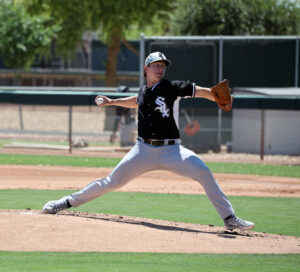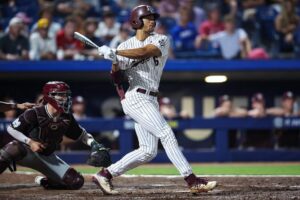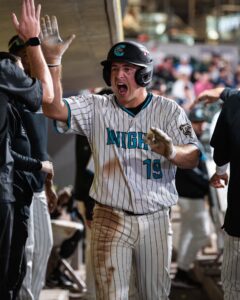2020 MLB Mock Draft 1.0
It’s never too early for an MLB mock draft.
These are unprecedented times and the Major League Baseball Draft is one particular element on the proverbial chopping block. With a lack of revenue entering the game due to a lack of contests being played, having a draft at all was a real question.
Under the most recent collective bargaining agreement, the Rule 4 player draft encompassed 40 rounds of selections. For this year, the owners have the right to shorten the draft to as few as five rounds while many in the industry still believe that the 2020 draft will involve 10 rounds in the end. The changes to the process are stark, however.
Instead of an increase in bonus amounts, those slot values will remain the same as 2019. Players who don’t get drafted will be limited to bonuses of $20K which is a direct contrast to the previous system and will put many good players in limbo.
The owners will also defer signing bonus payments for drafted players this year. In recent years, a player could choose to receive the full signing bonus up front, but many prospects defer payments anyway.
Every drafted player in 2020 will receive $100K up front with the other portion of their signing bonus split evenly in 2021 and 2022. This is a significant change to the draft process. For example, a player signing for $8,100,000 would receive $100K right away with $4 million coming in 2021 and another $4 million owed in 2022.
The shortened draft will affect college juniors and high school seniors the most, but the majority of the top talent in the country will still sign professional contracts. With scouting operations on hold and nobody playing across the country, the boards are pretty much set at this point barring another change to the process. The draft could be moved back as far as late July, but the official date hasn’t been settled yet.
In a five round draft, the Chicago White Sox would be afforded a bonus pool of $7,744,700 and it would increase to $8,757,500 if the draft ends up being 10 rounds. This is our first attempt at a first round mock draft with the information that we have currently.
1. Detroit: Spencer Torkelson 1B Arizona St. University
Torkelson is 6’1″ and 205 pounds with a right/right profile as first base. He would be the first such player to go first overall but in times like these, he’s the safest selection for Al Avila. Torkelson has plus raw power and enough of a hit tool to project as a difference maker in the middle of a big league lineup in the future.
2. Baltimore: Asa Lacey LHP Texas A&M
This pick will likely come down to Lacey, Georgia righty Emerson Hancock and Vanderbilt slugger Austin Martin. Lacey is a 6’4″ 215 pound southpaw that projects at the top of a rotation. The Orioles could decide on whichever player is willing to take the smallest bonus in this spot.
3. Miami: Austin Martin SS/OF Vanderbilt
The Marlins front office is very familiar with Martin and took his Commodore teammate JJ Bleday last year. Martin has played all over the diamond and is the best college hitter in the class. He’s also a twitchy athlete with positional flexibility and very few flaws in his game.
4. Kansas City: Nick Gonzales 2B New Mexico State
Gonzales is a young junior and he has hit everywhere he’s been. There are some concerns over inflated stats due to the environment in which he plays but he was stellar in Cape Cod as well. The 5’10” 190 pounder is an average defender at second with potent offensive potential.
5. Toronto: Emerson Hancock RHP Georgia
The Blue Jays would be ecstatic to land this 6’4″ right hander who was the favorite to go #1 overall a few months ago. Hancock is definitely and option to go higher and he might be the best college pitcher in the draft class.
6. Seattle: Zac Veen OF Spruce Creek HS (FL)
6’5″ lefty slugger with a commitment to Florida. Veen has a chance for 5 above average tools with excellent raw power as his current carrying tool. He profiles as a corner outfielder but could start in center initially.
7. Pittsburgh: Reid Detmers LHP Louisville
The college heavy draft continues at the top and Detmers could move through the minor leagues in a hurry. He’s a strong, durable southpaw with a repeatable delivery and mid-rotation upside.
8. San Diego: Jared Kelley RHP Refugio HS (TX)
The Padres love to take prep players and Kelley is the best pitcher in the class. He’s a physical 6’3″ 215 pound righty with consistent fastball velocity and stellar command and control.
9. Colorado: Austin Hendrick West Allegheny HS (PA)
Hendrick is a 19-year-old lefty with a great hit and power combination. Hendrick is a corner guy with massive raw power and bat speed. Might have the best combination of hit and power in the prep class.
10. Angels: Max Meyer RHP Minnesota
Meyer is 6’0″ right hander with a plus fastball and the best slider in the draft class. He’s a quality athlete that can repeat a fluid delivery despite the size. Could be the first Minnesota 1st rounder since 2004.
11. White Sox: Ed Howard SS Mt. Carmel HS (IL)
The 6’2″ 185 pounder is the best prep shortstop in the 2020 class. Howard was a member of the Jackie Robinson West Little League Team and was also a member of the White Sox’s ACE program. Howard shows impressive bat speed with a projectable frame. He’s very athletic and will stay at shortstop long-term. The former Jackie Robinson West standout joined Matt Spiegel on 670 the Score and shared his exuberance about playing in the big leagues.
12. Cincinnati: Tanner Burns RHP Auburn
Another 6’0″ righty and Burns has had some injury history in college. He locates a mid 90’s fastball well though and also possesses a plus breaking ball. He’s a strong and athletic right hander with his only flaw being prototypical size.
13. San Francisco: Garrett Mitchell OF UCLA
Giants follow their recent game plan and take another college prospect. The 6’3″ 205 lefty was a prep standout three years ago that made it to UCLA ultimately. Mitchell is a toolshed with plus-plus speed, a plus arm and defense to go along with 70-grade raw power. Mitchell has played with Type 1 diabetes which could factor in for some clubs.
14. Texas: Heston Kjerstad OF Arkansas
One of the best power bats in the draft class. The 6’3″ 200 pounder also had great success with Team USA in the summer and has shown elite ability with wood bats. Kjerstad isn’t a great defender but shows a strong and accurate arm in a corner outfield spot.
15. Philadelphia: Garrett Crochet LHP Tennessee
Crochet was shutdown for a bit this fall but made it back shortly before everything stopped. The 6’6″ 220 pound southpaw sits 96-100 mph with his fastball and shows very high spin rates. Crochet also possesses a plus slider with an above average changeup. He has a solid delivery with clean arm action as well.
16. Cubs: Mick Abel RHP Jesuit HS (OR)
Abel is a 6’5″ 180 pound Oregon State commitment and the first selection of the Dan Kantrovitz era in Chicago. He possesses present stuff, future projection and pitchability. His fastball sits in the mid 90’s and he flashes three plus pitches. Abel is lauded for great maturity and makeup as well.
17. Boston: Pete Crow-Armstrong CF Harvard Westlake HS (CA)
18-year-old with a L/L profile is the latest star from Harvard Westlake High School. Crow-Armstrong makes loud, hard contact despite some swing and miss in his game. He’s more hit than power currently but the dynamic athlete provides stellar defense in centerfield.
18. Arizona: Robert Hassell OF Independence HS (TN)
Was the most consistent bat on the USA Baseball 18U National Team last year. He shows stellar bat control. Hassell hits the ball hard and has developing power. Also shows a pretty left-handed stroke with great eye hand coordination. His bat and arm are his carrying tools and he could remain in centerfield.
19. Mets: Patrick Bailey C North Carolina State
Bailey is a young junior and the top college catcher in the class. He is more power than hit and is a switch-hitter with solid raw power. Bailey is a solid defender but has a lack of wood bat success in the summer.
20. Milwaukee: Cole Wilcox RHP Georgia
Wilcox is a draft-eligible sophomore who is likely to go in round one. The 20-year-old has great stuff with a fastball in the 93-97 mph range and the chance at three plus offerings. Wilcox is athletic with a strong frame but possesses some reliever risk in his profile.
21. St. Louis: Austin Wells C Arizona
Wells is a draft-eligible sophomore after a stellar performance in the Cape Cod League. He’s a left-handed hitter with power to all fields and draws lots of walks. He does have some defensive questions but could adequately handle 1B or LF.
22. Justin Lange RHP Dallas Baptist HS (TX)
Lange has popped up this spring and has shown a fastball that consistently hits triple digits. The 6’4″ 190 pounder hails from Llano, Texas and the Nationals are very familiar with this type of profile
23. Cleveland: Carson Montgomery RHP Windermere HS (FL)
The Indians love young prospects and Montgomery is one of youngest in the class. He has electric stuff and was solid on the summer showcase circuit. Montgomery has a quick arm and athletic frame while showing a 94-95 mph fastball with a power breaking ball.
24. Tampa Bay: Nick Bitsko RHP Central Bucks East HS (PA)
Bitsko reclassified to enter the 2020 draft class instead of being old for the 2021 class. The Virginia commit has a physical 6’4″ 220 pound frame and looks the part of a frontline starter. Bitsko has a clean delivery and his fastball and curveball have plus potential.
25. Atlanta: Carmen Mlodzinski RHP South Carolina
6’2″ 230 pound righty that looked exceptional in the Cape Cod League over the summer. His fastball reaches 99 mph and he has the chance for three plus pitches. He is athletic with some repeatability issues.
26. Oakland: Casey Martin SS Arkansas
A toolsy middle infielder who is 5’11” 175 pounds. Martin has plus running ability and he’s a quick-twitch athlete with above average power. Martin is an elite runner and has a chance at 25 homers annually.
27. Minnesota: Bobby Miller RHP Louisville
Miller is a 6’5″ 220 pound righty. He’s big and physical and profiles as a workhorse starter. His power stuff is generally on display with an upper 90’s fastball as his calling card.
28. Yankees: Drew Romo C The Woodlands HS (TX)
This 6’1″ 205 pounder is the best defensive catcher in the 2020 draft class. He displays soft hands along with profiling as an excellent blocker and receiver. Romo has a strong, accurate arm as well. The switch-hitter shows raw power but possesses questions with his hit tool.
29. Dodgers: Daniel Cabrera OF LSU
Lefty hitter for both power and average that fits profile of some recent college picks for Los Angeles. Cabrera possesses a simple swing, solid power and a very high baseball IQ. He needs to cut down on the strikeout rate but has a chance to stay in centerfield as a professional.
47. White Sox: Jake Eder LHP Vanderbilt
Eder is a strong, physical southpaw that projects as a mid-rotation starter in the future. The lefty shows clean arm action and a three pitch mix highlighted by a 93-96 mph fastball. His curveball also shows plus but he needs to further develop his changeup to reach his ceiling.
84. White Sox: Isaiah Greene CF Corona HS (CA)
Greene had a strong summer on the high school circuit specifically in the Area Code Games. He possesses plus speed and will remain in centerfield long-term. He’s an aggressive baserunner and has a feel to hit. It’s a contact oriented approach but he has the chance for above average power in the future. The Missouri recruit has played well against top competition.
Want to know right away when we publish a new article? Type your email address in the box on the right-side bar (or at the bottom, if on a mobile device) and click the “Subscribe” button. Our list is completely spam free, and you can opt out at any time. Also, consider supporting FutureSox on Patreon! You can get early access to special articles and Patreon-only posts, in addition to more benefits you can read about here. Shop our exclusive merchandise! Show your support with the latest FutureSox apparel.






